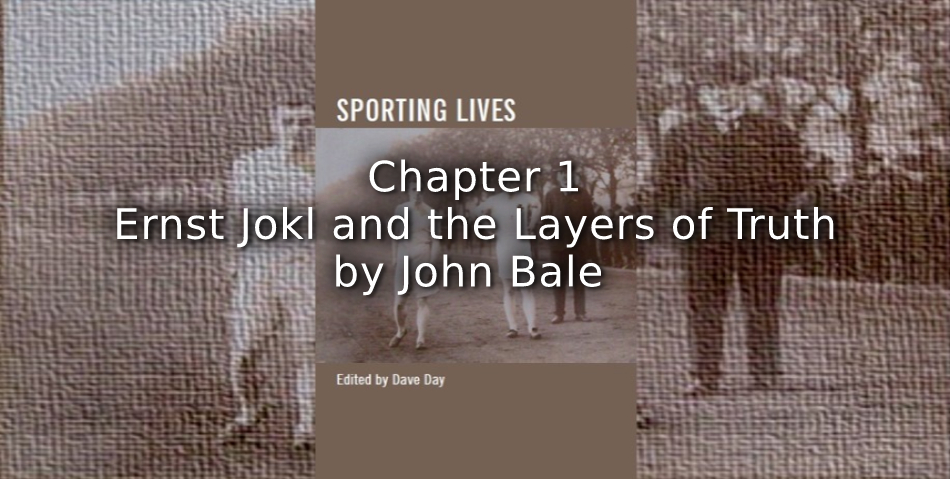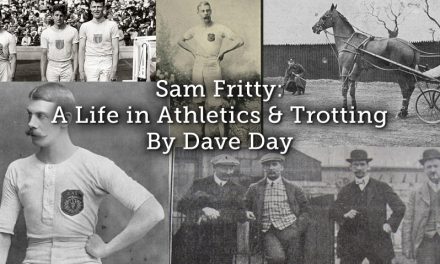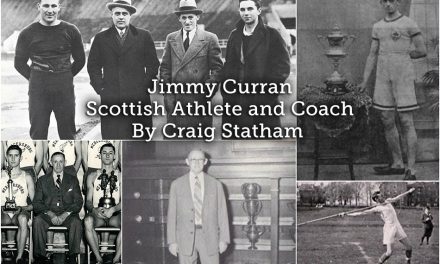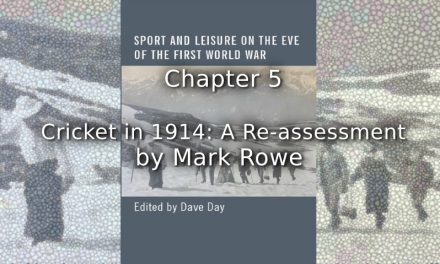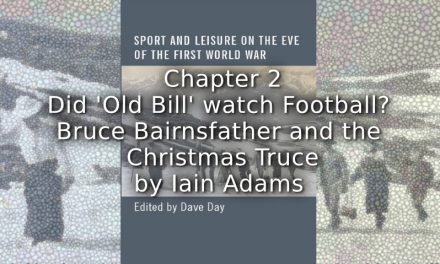Playing Past is delighted to be publishing on Open Access – Sporting Lives, [ISBN 978-1-905476-62-6] a collection of papers on the lives of men and women connected with the sporting world. This edited volume has its origins in a Sporting Lives symposium hosted by Manchester Metropolitan University’s Institute for Performance Research in December 2010.
Please cite this article as:
Bale, J. Ernst Jokl and Layers of Truth, In Day, D. (ed), Sporting Lives (Manchester: MMU Sport and Leisure History, 2010), 1-15.
Chapter 1
______________________________________________________________
Ernst Jokl and Layers of Truth
John Bale
___________________________________________________________
Those who write (auto)biographies tend do so for the same reasons as those who write per se. Seeking to categorise the reasons for writing, George Orwell suggested that writers, including biographers, write to seek the ‘truth’, to change the world, for the pleasure of writing good prose, and for the feeding of ego.[1] However, things are not as simple as this and self-depiction (or simply depiction) poses critical problems. Basic to writing a life is the recognition that writing is about representation: Biographies cannot tell the full story. Jerome Bruner adds that ‘an autobiography is not and cannot be a way of simply signifying to a ‘life as lived’: A life is constrained by the act of autobiography.[2] And consider the words of Philip Roth: ‘Memories of the past are not memories of facts but memories of your imagining of facts’.[3] In writing a biography, Vladimir Nabokov notes:
Don’t be too certain of learning the past from the lips of the present. Beware of the most honest broker. Remember that what you are told is really threefold: shaped by the teller, reshaped by the listener, concealed from both by the dead man of the tale.[4]
The hazards facing biographical studies are reiterated in numerous sources. Who could accurately write a complete human life in words? Jonathon Coe, the biographer of the avant garde ‘sixties novelist B. S. Johnson, wrote: ‘If even to condense the details of a comparatively short life … requires grotesque, enormous acts of compression and selection, what hope is there for the whole enterprise?’ Presumably then, he suggests that any attempts to represent a life results is a pack of lies.[5] In this paper I prefer to grapple with questions of truth and lies by taking the approach of Norman Denzin who writes:
Lives and their experiences are represented as stories. They are like pictures that have been painted over, and when paint is scraped off and old picture, something new becomes visible. And the stories about it have the qualities of pentiento. Something new is always coming into sight. Displacing what was previously certain and seen. There is no truth in the painting of a life, only multiple images and traces of what has been, and what is new.[6]
So, the postmodernist might say, what was fiction becomes truth or, fiction seeps quietly and continuously into reality. Indeed, all [representations] are fictions, before in the literal sense of fictio – something can be made. And there is no end of ways in which they can be made.[7] It is Denzin’s ‘model’ of representing a life that I adopt in writing some aspects of Ernst Jokl ‘fictional’ writing but first I think it is worth commenting on sports biographies per se.
Biography and Sport.
Are sporting biographies different from any other biographies? It has been suggested that sports biographies are more-de-politicised than others.[8] Also it has been suggested that sports biographies tend to reflect a career rather than a life. The perfect biography is impossible and the quality of literary representation various massively. For example, many sports biographies are hagiography, ghosted by journalists and written by a writer whose name differs from that on the cover. On the other hand, returning to Orwell’s categorisation, a ‘sport autobiography’ that seeks to ‘change the world’ is, I suggest, Pretty Good for a Girl by Leslie Heywood – an autobiography that illuminates the world of women’s long distance running and the brutal relationship between athlete and coach. This work could have ended up in the ‘muck-raking’ tradition of many sports books but partly because Heywood is a professor of English the book emerges as a committed study of modern sport.[9] An example of a ‘revisionist’ approach to biography is Brett Hutchins’s work on Donald Bradman in which he presents a revisionist view rather than an attempt to represent the conventional wisdom.[10] For elegant writing, there are few autobiographies than Roger Bannister’s First Four Minutes.[11] However, few studies have applied the ideas of Norman Denzin and my objective in this essay is to employ his idea of a ‘layers of truth’ or ‘traces’ while exploring part of the life of Ernst Franz Jokl.
Jokl: A Brief Overview
Ernst Jokl was born in Breslau (now Wrocław) in 1907 and died in Kentucky (USA) in 1997. I first encountered Jokl via his co-authored work on the 1952 Olympic Games in which he analysed quantitatively the athletes competing in the Games from a geographical perspective with the aim of correlating the performance of the nations and athletes represent.[12] I was impressed with this study and subsequently discovered other works that he had authored. Some years later he published what amounted to a repetition of his earlier work but added two somewhat gratuitous chapters on ‘Sport and Culture’ and ‘Sport and Human Development’[13] I recognised in Jokl a man with an eclectic range of interests and was intrigued by the subjects he chose to study.
Over the years he was acknowledged as a ‘father of American sports science’. He undertook medical training at the universities of Breslau and Berlin and in 1928 it seems that he assisted in some way in a study of the medical assessment of the athletes participating in the 1928 Olympic Games. In 1933 he married Erica Lessman, Lutheran Christian but his Jewishness led the Jokls to migrate to South Africa. There he became a lecturer at Witwatersrand Technical College and later a director of Physical Education at Stellenbosch and a physical education consultant to the South African Defence Corps. While in South Africa he developed a national programme of sports science and authored many articles on kinesiology, physiology, and sports.[14] His research output ranged across a dazzling array of subjects, from ‘aviation medicine’ to comparison of the physical efficiency of various South African ethnic groups. He also acted as trainer for the sprinters in the South African team taking part in the 1938 British Empire Games (Figure 1).
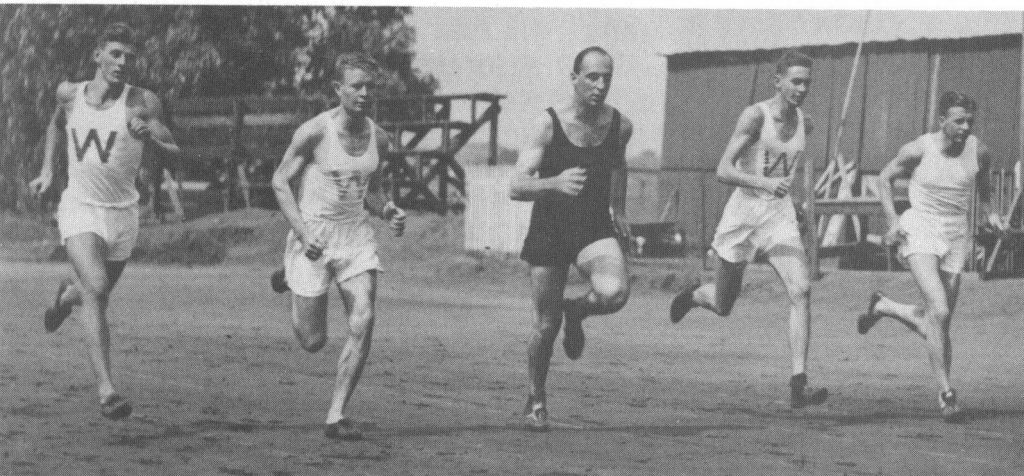
Figure 1
Ernst Jokl (in black vest) training with the South African sprint team for the 1938 Empire Games.
Following the Second World War the Jokls returned to Germany but Ernst was unable to find work and migrated to the USA, finding a job in the University of Kentucky at Lexington where he stayed for the rest of his life. However, he made many trips abroad, attending numerous conferences and being an active member of numerous sporting organisations. He worked in a variety of fields, ranging from rehabilitation, dance, exercise, sports medicine, anthropology, psychology and many more. In 1952 he led a substantial study of the Helsinki Olympics, aided by Finnish colleagues which sought to explore the geographical variations of sporting success.[15] Jokl’s life was one of energy. He was recalled as a brilliant lecturer. He was a major figure in the establishment of the American College of Sports Medicine and Physical Education (ICSSPE). He continued writing on various subjects, contributing a preface with the Duke of Edinburgh, on Drugs and Performance Horses. In his later years he received an honorary professorship at the universities of Berlin and Frankfurt and as a gesture of reconciliation Jokl Strasse in Cologne was named after him. In 1993 he received the Distinguished Service of the United States Sports Academy for his contribution to sports medicine.
This is a bland account of a life, the sort that is often found in an obituary or encyclopaedia. It is time now, however, to return to Denzin, his traces and his layers of truth.
Jokl – Sports Anthropologist
I now turn to a small though contentions point in Jokl’s academic career which raises questions about his career and the ways in which he has been represented. In his Reminiscences, a slim, self-published memoir in 1988, he recalled some of his work while living in South Africa. I was attracted to his reference to an alleged expedition that he had ‘organised’ to Rwanda. He wrote:
With the financial support of Sir Ernest Oppenheimer, I organised a research expedition to Ruanda-Urundi to study the traditional jumping ceremonies for young Watussis. The ceremonies had been described in 1906 (sic) by Adolf Friedrich, Duke of Mecklenburg, who visited Ruanda Urundi on behalf of the German Colonial Administration. … The Watussi jumpers took off from a mound one foot high. The best jumpers cleared 2.0 meters (6’7”). The sketches of them [Figure 2] were drawn from films by Ernst Ullman.[16]
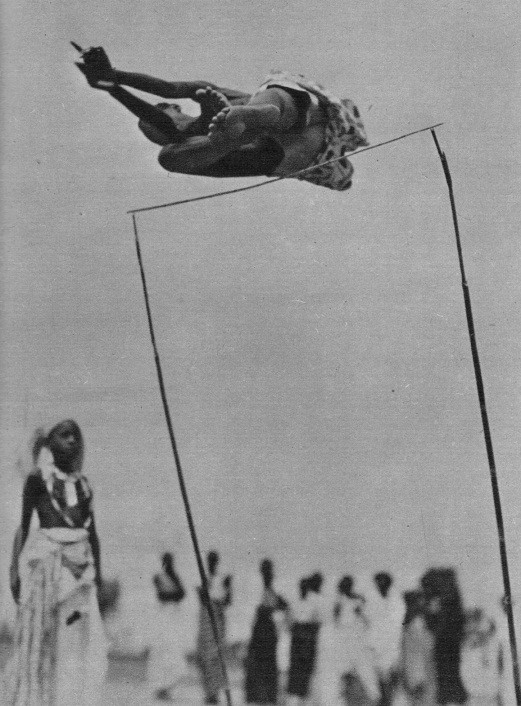
Figure 2
Typical representation of Rwanda high-jump
And that was all his Reminiscences had to say about the ‘traditional jumping’. It is in the above paragraph that I have to question the reliability of his writing.
As far as is known, the first written and photographic record of this form of jumping was indeed taken by the photographer attached to the expedition led by the Duke of Mecklenburg in 1907.[17] The configuration of Rwandan jumping, which differed from the European form in various ways (Figure 2), was subsequently represented in written and photographic form by many explorers and tourists during the first half of the twentieth century. It was usually attributed to Tutsi (who Jokl called ‘Watussi’) people, a group that made up about fifteen percent of the population but politically the most powerful.[18] Jokl authored at least four publications, each very brief, in which he alluded to the ‘Rwandan high jumpers’. The first and longest was a quasi-technical paper published in 1941 in an obscure Scottish source, The Journal of Physical Education and School Hygiene.[19] Jokl was an avid advocate of ‘developing’ the sporting potential of African peoples and
argued that the Rwandan high jumpers should be admitted to the Olympic games, despite the fact that their body-culture was neither sportised nor carried the same ideological baggage as Olympic high jumping. It can be reasonably assumed that his written references to the Rwandan jumping were the result of the Oppenheimer-funded visit, though Jokl does not acknowledge this benefice in his paper but does do so in his Reminiscences. However, anyone with the most rudimentary knowledge of Rwanda would recognise that there were several qualities in Jokl’s writing about the ‘Watussi’ jumpers that were mysterious to say the least. These can be catalogued as follows.
First, Jokl made the basic factual error of describing the majority of the population of Rwanda as being Tutsi. The most cursory knowledge of the composition of the Rwandan population would include the fact that at the time of Jokl’s visit, as noted above Tutsi counted for about 15 percent of the Rwandan population and that Hutu were the numerically dominant group. How Jokl could have made such a simple mistake is difficult to understand? Perhaps it was a slip of the pen which the copy editor failed to spot.
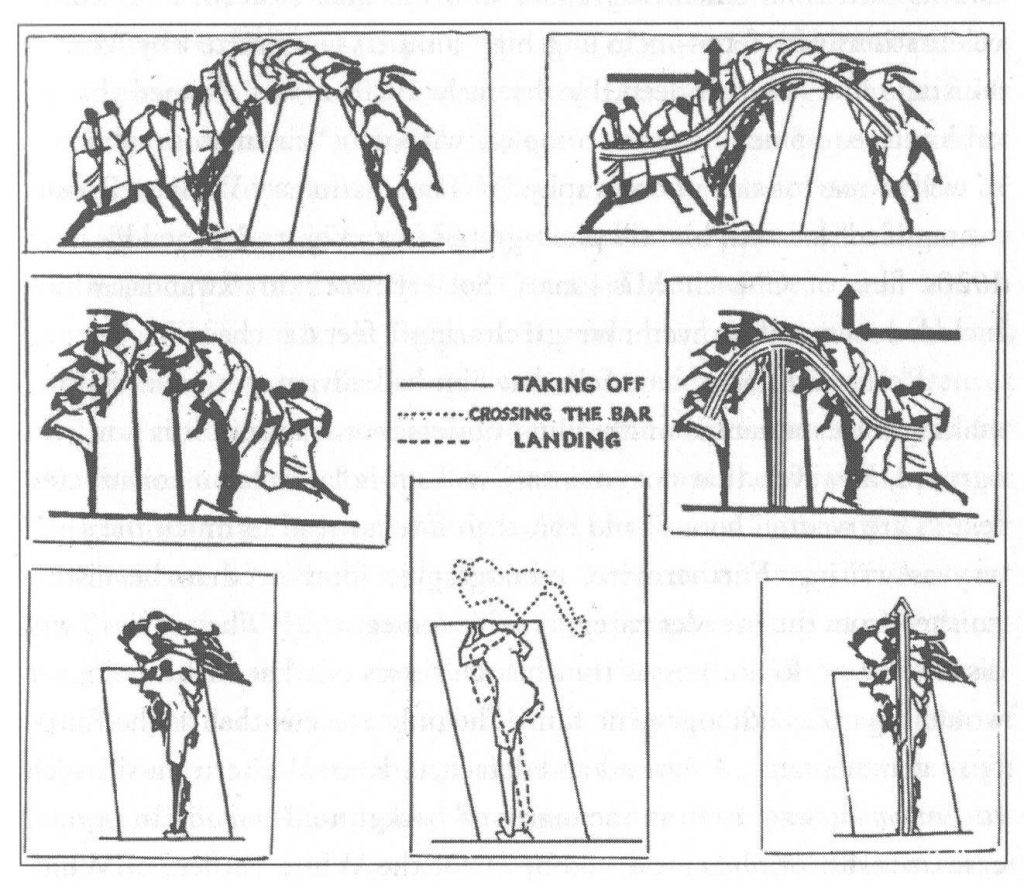
Figure 3
Generalising Tutsi.
Secondly, in his references to the Rwandan high jump, Jokl included diagrams that summarised the run-up, take-off and landing of the jumpers and served as a kinesiological model of their technique. The diagrams were made from a movie that, according to his 1941 paper, had been made by Professor J. H. Wellington but over forty years later, in his Reminiscences he attributed the movie to Ernst Ullmann who almost certainly drafted the diagrams of the jumping[20] (Figure 3). Perhaps this confusion was the result of Jokl’s advanced age when he wrote his reminiscences.
Thirdly, it cannot be said with any certainty that Jokl travelled to Rwanda and in his Reminiscences he states that he ‘organised’, rather than actually travelled to, Rwanda with the expedition. However, whether he went or delegated others to explore Rwandan body-culture, it seems reasonable that a 1930s traveller with anthropological interests would have taken a camera on his travels, especially to photograph the objects of the research – the Rwandan jumpers. However, in each of the published accounts of the high jump it was the Mecklenburg image of 1907 that was the only photographic illustration (Figure 4), an image that has been reproduced in many sources since.
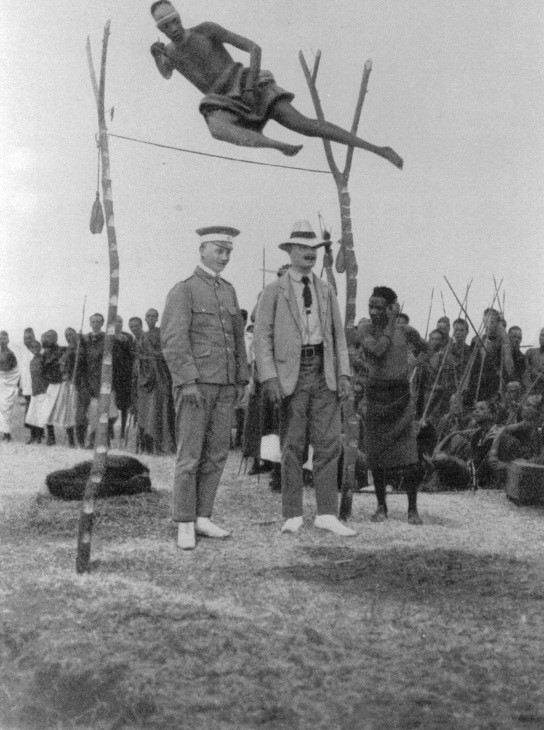
Figure 4
Untypical (Mecklenburg) representation of Rwanda ‘high-jump’.
Yet this is arguably the least typical of the many photographs of the jumping phenomenon that I have seen. Invariably, photographs of the jumping are shown by the much more typical configuration in Figure 2. Why didn’t he include a photograph by a member of his expedition in the late 1930s rather than rely on the Mecklenburg image of 1907? The Jokl archives at the University of Cologne reveal that there is no record of the visit made by Jokl to Rwanda.[21] It is, nevertheless, conceivable that no material from the visit were placed in the archive or/and no member of ‘his’ expedition took a camera with which to record the visit.
Fourthly, in one of his papers on the Rwandan jumping Jokl described the apparatus consisting of a hemp rope with weights at each end, placed between two upright over which the athlete jumped.[22] The only illustrations of this kind of apparatus (i.e. rope placed in notches, crudely cut uprights from branches of trees) that I have seen is taken from that on the 1907 expedition (Figure 4). In all other early photographs of the high jump, two upright reeds with another reed (Figure 2) placed over the top with the upright reeds sloping away from the on-coming jumper. There are neither ‘hemp rope’ nor weights. Indeed, Jokl contradicted himself by showing the configuration of the equipment in his Figure 2 – based on the movie noted above – which are not based on the Mecklenburg photographs but on other (non-Mecklenburg) images.
Finally, and perhaps the most serious, in none of his brief allusions to Rwanda did Jokl do anything other than quote secondary sources of the Rwandan jumpers. There is no suggestion in his writing that he ‘witnessed’, ‘observed’ or ‘recorded’ anything to do what he was writing about. Instead, for example, the heights achieved by the jumpers ‘are said by reliable observers’ to be around 7’2”.[23] It seems that he had not read Mecklenburg’s popular book in which it is claimed that the athlete in the photograph had cleared 2.50 metres (about 8’2”). Depending as he does, upon what he was told or witnessed on film and photograph, it is if he had never actually witnessed the jumping – or, perhaps, he did not regard the Mecklenburg photograph and the staggering statement of the 2.50 metres jump as unreliable.
I now return to Denzin’s observations on ‘traces’ of truth. Two simple traces can be seen in the ‘story’ of Jokl’s study of the high jump. First, Jokl presented himself as an expert on Rwanda by publishing his ‘research’ in an ‘academic’ journal. Secondly, a layer is scratched away to revel him as an ignoramus. One can speculate that he had never visited Rwanda – and what happened to the ‘financial support’?
Jokl – Athlete
Jokl was not only a student of body cultures. In his youth he was an athlete, a good sprinter (Figure 1) and his wife was a gymnast. Jokl recalls that in 1924 he ran the final leg of his university’s 4 x 400 metres relay team in ‘under fifty seconds at the age a seventeen.[24] If true, this would have been an impressive performance. He also competed in the 400 metres hurdles, his best time being apparently 58.0 seconds, made in a race in Berlin in 1927 in which he finished third.[25] According to ranking lists collected by the Association of Track and Field Statisticians, this ranked him as the 44th fasted in the world for this event that year. He also competed in the shorter sprints and the high and long jumps in which he achieved more modest results.[26]
A number of written accounts state that Ernst Jokl was a member of the German track and field team which competed in the 1928 Olympics in Amsterdam. Jokl was, according to at least two sources, ‘an outstanding 400-meter and hurdler for the German Olympic team in 1928’.[27] In an interview as part of a study of the P.E. department at Stellenbosch, it is reported that Jokl himself stated that he had competed in the 1928 games in the 400 metre hurdles and that he had won German titles (Hy het later as baanatleet bedenheid in Duitsland verwerf en by twee geleenthed nasionale titlesverower. In 1928 was hy lid von de Duutse atletekspan spele in Amsterdam, waar hy aan die 400 metres hekkies deelgeenen het). However, an obituary notice records that [28] Jokl ‘made the 1928 Olympic team as an alternate in the 400 metres hurdles, but did not compete’.[29] That he was an alternate of substitute for the team was supported by an email communication from Jokl’s daughter.[30]
A further trace of ‘the truth’ can be exposed exploring the statistical records of the results of, and participation in, the 1928 Games. A careful reading of all Olympic results, the names of all entrants for the 1928 games, all the athletes who have ever competed for Germany in the Olympics, the German Olympic Committee’s list of Olympians and several other gazetteers, fail to reveal the name Jokl, Jockl, or Joekl. One of the most eminent track and field statisticians in the world, with a specialist interest in the Olympic Games, is adamant that Jokl never competed in the Olympics.[31] Nor does it seem that he was an alternate (reserve). He did not take part in the 1928 German championship, nor achieved a performance that ranked him in the top thirty in German in any event. Arnd Krüger and Karl Steinnmetz, leading track and field scholars, dismiss the idea that he could have been a reserve, the latter laughing it off as being ‘utterly ridiculous’.[32] Yet another trace of Jokl’s life seems to have been removed. Nor does it seem that he ever won any German titles. He never finished in the first six in any event at the German championships – except, that is, as a member of the VfB track club’s 4 x 400 metres relay team which finished second in the 1927 National championships.[33].
In passing, it can be mentioned that Erica Jokl was named as a member of the German track and field team and a gymnastics ‘gold medallist in the 1928 Olympics[34], a view seemingly supported by Jokl himself.[35] Jokl’s daughter informed me that her mother won a group medal for a collection of sporting activities which included discus, jumping, javelin, and a group gymnastic performance.[36] Jokl’s grandson reported a more or less identical story.[37] Yet , as with the case of Ernst Jokl, there is no record of any Olympic participation for Erica Jokl or Lestmann in the 1928 Games. Indeed, there was no German team in the gymnastics events of the 1928 games. The most that can be said is that she awarded a medal for one of several unofficial and little-known exhibitions or demonstrations events that took place alongside the Olympics but not officially part of the Games.
Attempting to write even part of the life of Ernst Jokl perfectly exemplifies Denzin’s notion of something new always becoming visible in biographical work. Likewise, Nabokov’s caution about oral evidence, even from members of the biographical object’s family and himself, is shown here as being fraught with uncertainty and, apparently, untruth. It might also be worth returning to the words of Jerome Bruner: ‘Perceiving and remembering are themselves constructions and reconstructions’.[38] In tempting to write Jokl’s engagement with the 1928 Olympics, it appears that it was almost all rhetorical (Table 1).
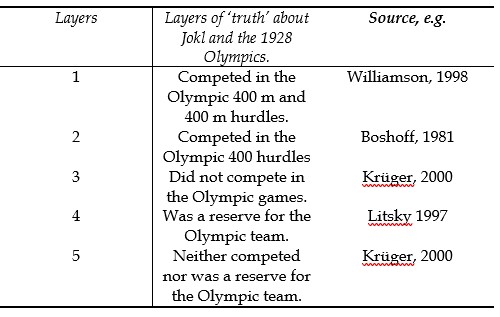
Table 1.
‘Traces’ of truth about Jokl’s 1928 Olympics
Representing Ernst Jokl
The ambiguous nature of the two events (the Rwanda and Amsterdam episodes) illustrates clearly some of the hazards of writing both history and biography. But how many more layers of truth could be exhumed? What do these two cases tell us about Jokl as a scholar and, perhaps more importantly, as a human being? In response to these questions I explore Jokl as a ‘placeless’ person and secondly as a ‘trickster’, practicing perhaps not a life of sport but one of disport.
Jokl’s life gives the impression of being focussed around work and sport. But he was central to neither. He was characterised by his fluidity and marginality rather than rootedness and centrality. He was a man at the margins, placeless, socially, professionally and as a sportsman. Let me elaborate. Coming from Breslau, he was born at the margins of Germany and Poland. He was known to be a Jew on his father’s side and can also be seen as being marginal of, successively German, South African and American society. He seemed to be Jew-ish than Jewish. To be sure, he was sufficiently Jewish to represent the Kochba (Jewish) track club while in Berlin and leave Germany in 1933. On entry to South Africa he described himself as a ‘German refugee’[39] and he was recognised as Jewish by both the editor of South African Jewry[40] and by his obituary writer in the New York Times[41] though members of his family felt that ‘the German part of his family felt that ‘the German part of his identity was far more dominant’.[42] There is more than a suggestion that he did not project his Jewishness while in South Africa and Jews or Jewishness is not mentioned in his Reminiscences. One of my informants told me that her family knew Jokl well while in South Africa but they never regarded them as Jewish and were amazed when they told he was. Another informant, a friend and colleague of Jokl wrote:
Concerning his Jewishness … this is a rather complex question. He often told me that he was half-Jewish since his mother was not … As far as I know in the Jewish cemetery in Wrocław there was his father’s grave … When we were together in Israel on the occasion of several scientific seminars he occasionally told me that his ancestors were indeed Jewish, but that he felt to himself to be a Christian!
Others who knew him also felt that he was more a German than a Jewish stereotype. Yet the ambivalence of his Jewishness is revealed by his ‘on and off’ affiliation to the local synagogue during his life in Lexington[43] and the fact that on occasions he seemed to urge non-practicing back into the faith.[44] ‘Feeling Jewish’ is at one definition is at least one defining of being Jewish.[45] Jokl’s personal identity was ambivalent to say the least. His placelessness, being neither one thing nor the other, could be put into operation when the need arose. He seems to me to be reminiscent of Woody Allen’s Zelig, a ‘chameleon man’ who could adopt the guise of anyone he liked, at a moment’s notice. In the academic world Jokl’s vast range of publications leads to the problem of categorisation. Where can he be placed academically?
He was apparently not allowed to practice in Kentucky, not being a qualified medical doctor (or, more accurately, not having any proof that he was). So, he was not a ‘proper’ medical doctor. Nor was he a qualified anthropologist but this did not prevent him publishing quasi-anthropological studies, calling his co-authored study of the 1952 Olympics a ‘medical anthropology’. He was not a central player in any academic discipline and therefore ran the risk of interdisciplinarity with its shallowness and lack of digestion. The fact that he had no training in dance, veterinary science, and anthropology did not stop him publishing papers in these subjects. He refused to be ‘placed’ and being placeless Jokl might be seem to have transgressed the norms of ‘the specialist’ in academic life.
Jokl, Joker / Jokl-Sokal?
Another way of (perhaps more speculatively) reading Jokl is to see him as a joker or trickster who not only blurred distinctions of academic disciplines but also between truth and fiction. He carnivalised sporting discourse by transgressing disciplinary norms. For example, careful reading by specialist in a variety of subjects would be needed to scrutinise his writing with great care before one could be sure he was not an imposter. Is it taking things too far to suggest that he was a (modest) forerunner of Alan Sokal, an American physicist who submitted a nonsensical spoof paper to the trendy journal, Social Text – and whose editors published it, assuming it to be a serious paper?[46] Like Sokal’s hoax article, Jokl’s Rwanda paper (and how many others?) was ‘liberally scattered with nonsense’, even though it ‘sounded good’.[47] It may have flattered the editor of a now defunct, little known, modest journal of physical education. A possible difference between Jokl and Sokal is that the latter’s spoof was deliberate while Jokl was simply sloppy. Or was Jokl trying to hoax his readership, most of whom were hardly experts on Rwanda and its body cultures. Or was it simply that the editor or reviewer was insufficiently au fait with the subject of the paper? Did Jokl really care whether his facts were right or wrong? Was he submitting yet another paper to be published on his route to become a polymath?
A final reading of Jokl is that he was a clown – the dialogical ‘other’ of official academic culture, contaminating the supposedly monological voices of the powerful when he ventured into the world of sports anthropology? Jokl the jester could be seen as a representative of the carrnivalesque, or a writer of ‘sport’ – the word being used in nineteenth century literary circles to describe a work that cannot be satisfactorily categorised.[48]
References
[1] George Orwell, ‘Why I Write’, in Decline of the English Essay (Harmondsworth: Penguin, 1978), 180-87.
[2] Jerome Bruner, ‘The autobiographical process’, Current Sociology 43, no. 2 (1995): 161.
[3] Philip Roth, The Facts (New York: Penguin, 1988).
[4] Vladimir Nabakov, The Real Life of Sebastian Knight (London, Penguin, 1941).
[5] Jonathon Coe, Like a Firey Elephant (London: Picador, 2004).
[6] Norman Denzin, Interpretive Biography (Beverley Hills, Sage, 1985), 81.
[7] Derek Gregory, ‘Areal Differentiation and Post-Modern Geography’, in Horizons in Human Geography, in (eds.) Derek Gregory and Rex Walford (London: Macmillan 1994), 78-112.
[8] Gyöngyi Szabó Földesi, ‘The use of Autobiographies in Sport Sociology’, in Otmar Weiss and Wolfgang Schultz (eds.), Sport in Space and Time (Vienna: Universität Verlag, 1995), 147-56.
[9] Leslie Heywood, Pretty Good for a Girl (New York, The Free Press, 1998).
[10] Brett Hutchins, Donald Bradman: Challenging the Myth (Cambridge, Cambridge University Press, 2002).
[11] Roger Bannister, First Four Minutes (London: Putnam, 1955).
[12] Ernst Jokl, M. J. Karvonen, J. Kihlberg, A. Koskella and L. Noro, Sports in the Cultural Pattern of the World, (Helsinki: Institute of Occupational Health, 1956).
[13] Ernst Jokl, Medical Sociology and Cultural Anthropology of Sport and Physical Education, (Springfield: Charles C. Thomas, 1964).
[14] Van de Merwe, ‘Ernst Franz Jokl as the Father of Physical Education in South Africa?’, Paper presented at the annual conference of the North American Society for Sports History, Banff, (1990).
[15] Jokl et al, Sports in the Cultural Pattern of the World.
[16] Ernst Jokl, South African Reminiscences (Lexington, Jokl, 1988), 13.
[17] Adolf Friedrich Mecklenburg, In Central Africa (Cassell: London, 1910).
[18] John Bale, Imagined Olympians (Minneapolis: University of Minnesota Press, 2002).
[19] Ernst Jokl, ‘High Jump Technique of the Central African Watussis’, The Journal of Physical Education and School Hygiene, 33, (1941) 145-151.
[20] Jokl, South African Reminiscences.
[21] W. Sonnenscheim, quoted in Bale, ‘The mysterious Professor Jokl’.
[22] Ernst Jokl, Physiology of Exercise (Springfield: Charles C. Thomas, 1964).
[23] Jokl, 1941, ‘High Jump Technique’ p. 146.
[24] Ernst Jokl, ‘Indisposition after running’, in E. Jokl and E. Simon (eds.), International Research in Sport and Physical Education, (Charles C. Thomas, Springfield, 1960), 682-692.
[25] Arnd Krüger, quoted in Bale, ‘The mysterious Professor Jokl’
[26] A. Boshoff, ‘Die geskiedenis van die Department van Liggaamlik Opvoed-kund aan die Universiteit van Stellenbosch’, (Unpublished master’s thesis, University of Stelenbosch, 1981), 3.
[27] D. Williamson, ‘Life saving Dr. Mueller selected to get sports medicine aware’, http:www.unc.edi/news/newserv/research/muell6 (accessed 1998).
[28] J. Kane, ‘Ernst Jokl’s 85th Birthday’, ISCCPE Bulletin, 16, (1993) 22-23;1993; S. Bailey, Science in the Service of Sport and Physical Education, (Chichester: Wiley, 1996) 17; M. Hebbelink, ‘Prof. Dr. Ernst Jokl’, ICSSPE Bulletin, 23, (1997) 16-17.
[29] F. Litsky, ‘Dr. Ernst Jokl, a pioneer of sports medicine, dies at 90’, New York Times, November, (1997).
[30] Ball, quoted in John Bale, ‘The Mysterious Professor Jokl’ in Writing Lives in Sports, ed. John Bale, Mette K. Christiansen, and Gertud Pfister, (Aarhus: Aarhus University Press, 2004), 25-40.
[31] Mallon, quoted in Bale,‘The Mysterious Professor Jokl’.
[32] Quoted in Bale, ‘The mysterious Professor Jokl’.
[33] Ibid.
[34] P. Schneider, ‘Technology ambassador’, Healthcare Information on Line, http://healthcare-informatics.com, (accessed 1998).
[35] Boshoff, ‘Die geskiedenis van die Department’, 1981, p. 35.
[36] Ball, quoted in Bale, ‘The Mysterious Professor Jokl’ (2003).
[37] Ball , quoted in Bale, ‘The Mysterious Professor Jokl’ (2003).
[38] Quoted from D. McCooey, Artful Histories: Modern Australian Autobiography (Cambridge; Cambridge University Press, 1996), 8.
[39] Jokl, Reminiscences, (1988), 180.
[40] A. Goldman, ‘The World of Sport’, in M. Arkin (ed.), South African Jewry, Cape Town, (1984).
[41] Litsky, ‘Dr. Ernst Jokl, a pioneer of sports medicine’.
[42] Ball, quoted in Bale, ‘The Mysterious Professor Jokl’.
[43] Ibid.
[44] A. D. Munrow, A. D. Munrow’s Travel Diary and Commentary, (unpublished typescript, Centre for Olympic Studies, University of Queensland, 1956), 73.
[45] George Eisen, ‘Jews and sport: A century of retrospect’, Journal of Sport History, 26, (1999), 225-39.
[46] A. Sokal and J. Bricmont, Intellectual Imposters (London: Profile Books 1999).
[47] R. T. Carroll, ‘The Sokal Hoax’, The Skeptics Dictionary, http://skepdic.com/sokal.html (accessed 13/3/02.).
[48] Robert Polhemus, ‘Lewis Carroll and the child in Victorian Fiction’, in The Columbia History of the British Novel, (ed. John Richetti), (New York: Columbia University Press’ 1994), 579-606.

